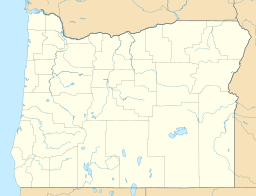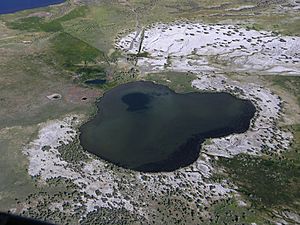Borax Lake (Oregon) facts for kids
Quick facts for kids Borax Lake |
|
|---|---|
 |
|
| Location | Harney County, Oregon |
| Coordinates | 42°19′37″N 118°36′11″W / 42.327°N 118.603°W |
| Primary inflows | Geothermal springs |
| Primary outflows | Ground seepage and evaporation |
| Basin countries | United States |
| Surface area | 10 acres (4.0 ha) |
| Surface elevation | 4,078 feet (1,243 m) |
Borax Lake is a special lake in southeastern Oregon, USA. It is about 10 acres (4.0 ha) big. The lake is in the Alvord Desert. It gets its water from hot springs deep underground. These springs are about 100 feet (30 m) below the surface. The water from these springs can be very hot, from 104 to 300 °F (40 to 149 °C). The lake's surface water is usually warm, from 61 to 100 °F (16 to 38 °C). Sometimes it gets even warmer. These hot springs are found along a crack in the Earth called the Steens fault zone. This fault runs north to south near Steens Mountain.
Borax Lake has a lot of borax in it. Borax is a natural mineral. The lake also has small amounts of arsenic and lead. Even with these things, a special fish lives here. It is called the Borax Lake chub. This fish is found nowhere else in the world!
Years ago, people wanted to use the hot water from the springs to make energy. This could have hurt the Borax Lake chub. But in 1993, a group called The Nature Conservancy bought the land around the lake. They bought about 160 acres (65 ha) to protect the lake and its fish. The U.S. Fish and Wildlife Service also set aside 640 acres (260 ha) nearby as a "critical habitat." This means it is very important for the fish.
In 2000, a law was passed. It stopped any new energy projects or mining near the lake. This helps keep the lake and the fish safe. Borax Lake and other nearby wet areas are also important for many kinds of birds.
History of Borax Lake
In the late 1800s, a mining company came to Borax Lake. The company was called Rose Valley Borax. They bought the land and the hot springs. Borax salts from the springs had built up on the ground. They formed a low hill about 1 mile (1.6 km) wide.
The company mined the borax for about 10 years. They used wagons pulled by mule teams. These teams carried the borax to a train station in Winnemucca, Nevada. The mining stopped in 1902. You can still see the ruins of the old mining buildings near the lake today.
People became interested in mining for borax again in the 1940s and 1950s. A scientist studied the hot springs around Borax Lake. In 1960, he wrote about how much borax might still be there. He thought about 150 short tons (140 t) of borates could form each year. This was from Borax Lake and another hot spring nearby.





